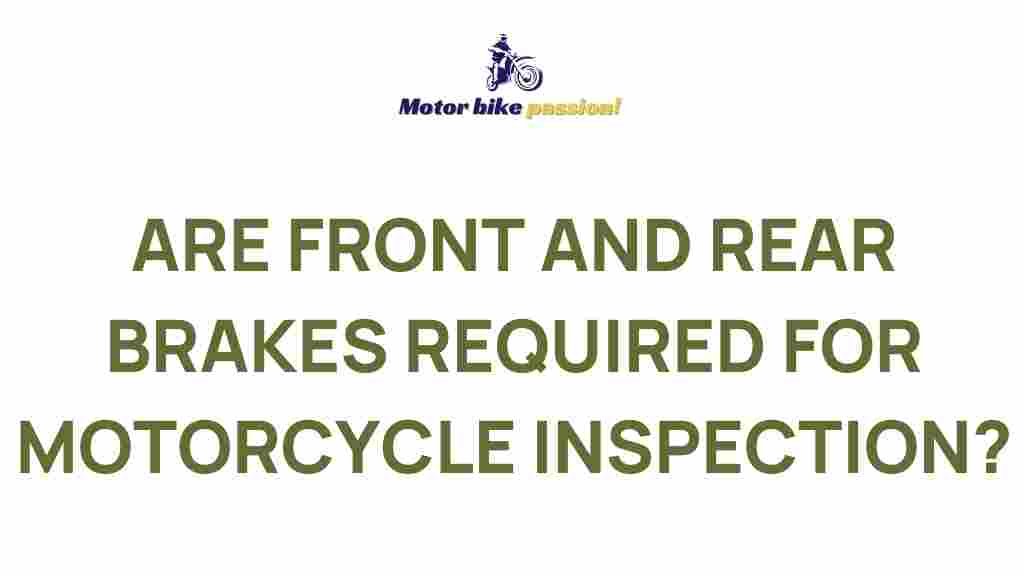Uncover the Essential Components of Motorcycle Inspections
Motorcycle inspections are crucial for ensuring safety and performance on the road. Whether you’re a seasoned rider or a new enthusiast, understanding the components of a motorcycle inspection can help you maintain your bike in prime condition. In this article, we will delve into the essential aspects of motorcycle inspections, focusing on front brakes, rear brakes, and other important safety and maintenance regulations.
Why Motorcycle Inspections Matter
Regular motorcycle inspections are not just a legal requirement; they are vital for your safety and the longevity of your motorcycle. Here are some reasons why motorcycle inspections are essential:
- Safety: Inspections help identify potential issues that could lead to accidents.
- Performance: Keeping your motorcycle in top condition ensures it performs well.
- Regulatory Compliance: Many regions require periodic inspections to comply with local laws.
- Cost Savings: Early detection of problems can save you money on costly repairs down the line.
The Motorcycle Inspection Process
Conducting a thorough motorcycle inspection involves several steps, each focusing on different components of your bike. Below is a step-by-step guide to help you through the process.
1. Visual Inspection
Start with a visual inspection of the motorcycle. Look for any obvious signs of wear and tear, such as:
- Cracks or leaks in the frame and bodywork
- Condition of the tires (tread depth, cracks, or bulges)
- General cleanliness of the motorcycle
2. Checking the Brakes
Brakes are one of the most critical components for safety. Both front brakes and rear brakes should be inspected thoroughly:
Front Brakes
- Inspect the brake fluid level and condition.
- Check the brake pads for wear; they should not be less than 1/8 inch thick.
- Look for any signs of leakage around the brake calipers.
- Test the brake lever for proper feel and response.
Rear Brakes
- Similarly, check the rear brake fluid level.
- Inspect the rear brake pads for wear and replace them if necessary.
- Ensure the rear brake lever feels firm and responsive.
- Look for any signs of wear in the brake line.
3. Tires and Wheels
The tires are the only contact your motorcycle has with the ground, making them vital for safety. Check the following:
- Tread depth: Use a penny to gauge the depth; if you can see all of Lincoln’s head, it’s time to replace the tire.
- Pressure: Ensure that the tire pressure matches the manufacturer’s specifications.
- Wheels: Inspect for any dents or cracks.
4. Lights and Electrical Systems
Ensure all lights are functioning correctly:
- Check the headlights, tail lights, turn signals, and brake lights.
- Inspect the battery condition and connections.
- Test the horn and any other electrical accessories.
5. Fluid Levels and Leaks
Check all essential fluids, including:
- Engine oil: Ensure it is at the proper level and check for contamination.
- Coolant: Check the level and look for leaks.
- Brake fluid: As previously discussed, ensure it is full and clean.
6. Chain and Drive System
The chain and drive system should be inspected for:
- Proper tension: The chain should not be too loose or too tight.
- Lubrication: Ensure the chain is well-lubricated to avoid wear.
- Signs of wear on the sprockets.
Troubleshooting Common Issues
During your inspection, you may encounter common issues that require troubleshooting. Here are some tips:
- Brake Issues: If either the front or rear brake feels spongy, it may indicate air in the brake lines. Bleed the brakes to remove the air.
- Tire Problems: If you notice uneven wear, it could be a sign of improper alignment or suspension issues. Have it checked by a professional.
- Electrical Failures: If lights are not functioning, check the fuses and connections. Replace any blown fuses.
Understanding Regulations
In many regions, motorcycle inspections are mandated by law. It’s essential to be aware of the specific regulations in your area. Typically, inspections may cover:
- Safety features such as lights and brakes
- Emissions standards if applicable
- General roadworthiness of the motorcycle
For more detailed information, you can check with your local Department of Motor Vehicles or visit official motorcycle regulation websites.
Conclusion
Regular motorcycle inspections are a critical aspect of motorcycle ownership. By understanding the essential components of motorcycle inspections, including front brakes, rear brakes, and other safety features, you can ensure your bike remains in excellent condition. Remember that regular maintenance not only keeps you safe but also prolongs the life of your motorcycle.
Make inspection a regular part of your motorcycle maintenance routine. If you’re ever in doubt, consult a professional mechanic or refer to your motorcycle’s owner manual for specific guidance. For more tips on motorcycle maintenance and safety, feel free to explore our other articles, or check out this helpful resource.
This article is in the category Safe Driving and created by MotorBikePassion Team
